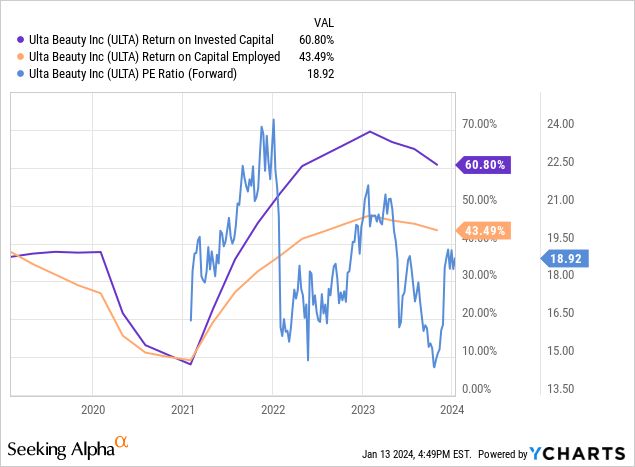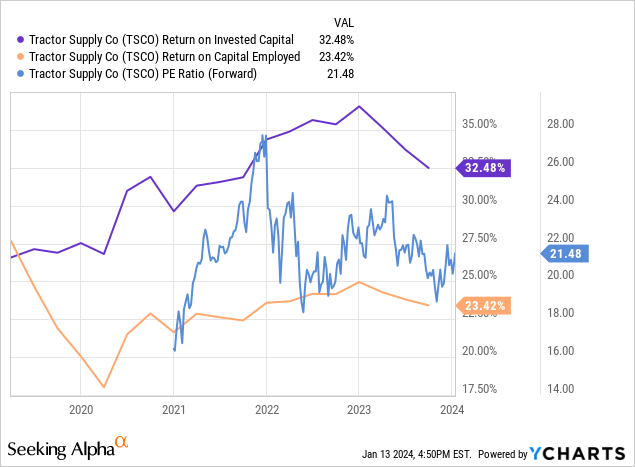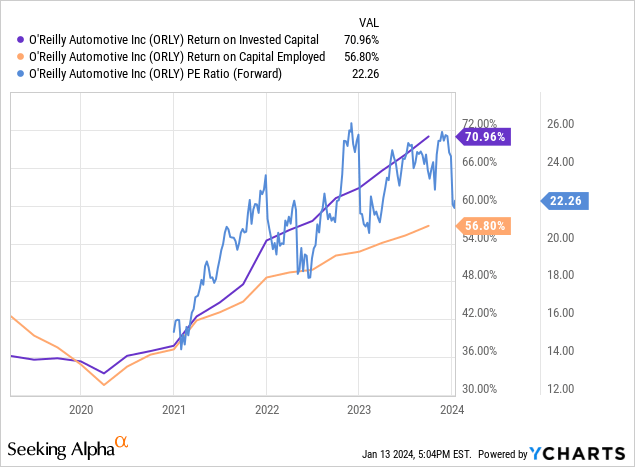Adene Sanchez
Why Retail?
Some will say they just don’t like retail. Munger and Buffett had arguments about this issue when Munger was a fan of Costco (COST), and Buffett wasn’t into it as much. I’d say Charlie was right. People don’t like retail because it’s hard to differentiate yourself from other competitors, and there are low barriers to entry. However, I like retailers. I appreciate them because it’s simple. It is easy to understand the business and what it sells, and as a customer, you have a sense of how the service is. Some retailers have found the formula to expand growth while remaining very profitable, and once the company is on that formula, it is hard to stop.
Today, I’ll present you with five retailers that, in my view, are of high quality and have beaten the market in the last decade. Additionally, I believe they are at a reasonable price.
My investment approach
I primarily invest in high-quality businesses—those with high, preferably growing returns on capital, solid growth, and a good capital allocation strategy. I look for a robust balance sheet and competent management. If the business is easy to understand, that’s a bonus, which is why I favor retail. I prefer businesses with a strong brand and relative resilience to economic instability. Since it’s challenging to find such businesses at a cheap price, I aim to buy them at reasonable prices. The ideal situation for me is to purchase a business when it’s trading under its multiples averages, creating room for multiple expansion. The combination of multiple expansion and solid organic growth is what we all strive for in terms of returns.
Ulta Beauty
What I appreciate about Ulta (ULTA) is its strong brand power and customer base. With more than 40 million membership customers, accounting for 95% of its sales, ULTA has a significant presence. Most of ULTA’s customers are classified as beauty enthusiasts, known for their frequent purchases. One aspect I admire about the beauty and cosmetics industry, which also attracts me to L’Oreal (OTCPK:LRLCF), is its resilient and recurring nature. Women continue to buy makeup regardless of economic conditions, evident in ULTA’s last twelve months revenues growing at 12%, as well as L’Oreal’s revenues experiencing double-digit growth.
ULTA has emerged as the preferred ‘beauty destination’ for 42% of surveyed female teenagers, a testament to its brand power. I believe the management, led by David Kimble, is competent, with solid incentives and a significant stake in the company. ULTA presents great margins for a retailer, around 15% EBIT, along with a 5-year average ROIC of 25% and a 32% ROCE. High and stable ROC metrics serve as my indication of a high-quality business, and when coupled with solid growth, it becomes an immense value creator.
EPS growth expectations could well be in the low-double digits CAGR in the future. driven by industry growth, market share expansion, store count growth, and significant buybacks. A forward PE of 18 is not excessively high, considering the company’s expected 10% CAGR and a return north of 30% ROCE. This multiple is also below ULTA’s average, providing an opportunity for a return to the mean.
I have written two articles (1st, 2nd) about Ulta in the last few months that will help you grasp the business.

Tractor Supply
Although it’s trading at a slightly higher multiple than Ulta, I believe there is a reason for that. Some reasons include that 50% of its product offerings revolve around pet and livestock items, creating a steady stream of revenue and offering recession-resistant products. The business’s niche focus is another aspect that appeals to me. Instead of trying to compete with giants like Lowe’s (LOW) and The Home Depot (HD), Tractor Supply (TSCO) has carved out its niche market and managed it like a masterpiece, with each store boasting a 20-30% return on invested capital.
A key driver of this success is its loyal customer base, currently standing at 28 million members out of the 46 million Americans residing in rural communities. The company attributes much of its customer retention to the exceptional service provided by its employees (a common trait among all of the businesses here). Another profitable method TSCO is using is private-label brands, constituting 30% of its revenue. These brands, naturally carrying higher margins, contribute to an upward trajectory in overall margins over time.
There are a couple of growth trends that will boost same-store sales for TSCO. First up, there’s the increasing spending by younger generations on their pets, coupled with a rising adoption rate. Another growth avenue stems from the trend of people moving away from cities, seeking a more rural lifestyle with larger, more affordable homes.
For TSCO, we can assume a high-single digit EPS CAGR looking long-term factors, including comparable growth, store count growth, and solid buybacks. This growth also comes with great profitability and efficiency, with a 5-year average ROIC of 21% and ROCE of 25%.
The multiple is now at 21 times FWD earnings, also under historical multiples, with the potential for minor multiple expansion.
Delve deeper into TSCO in my December article.

AutoZone
AutoZone (AZO) is a long-time performer and a share cannibal, as we will see later. There are numerous factors to appreciate about it. What shields AutoZone’s business from the disruption of e-commerce is the immediate necessity for their products. If your car has a problem, and you need to get to work, waiting for a product to be delivered isn’t an option. You’re more likely to buy it immediately, and the expertise of AutoZone staff helps you make informed choices. Service plays a crucial role in this retail business as well. Since most people are not car enthusiasts, the expertise of AutoZone workers and their catalog help customers choose the right product for their specific needs.
I also like the industry, being fragmented and slowly consolidating by the big players. The industry is quite predictable. There’s a consensus among car companies regarding offering a seven-year warranty on vehicles. This predictability allows you to anticipate future demand. In the industry, there’s a concept known as the ‘sweet spot,’ which refers to the period after the warranty has expired but before the vehicle is taken off the road. This typically falls within the 8-12 year range, but with the aging of active cars in recent years, this ‘sweet spot’ has extended. What I appreciate about this industry is its essential nature. People require car parts to keep their vehicles running, and this need is continuous.
AutoZone has expanded its operations into two additional countries: Mexico and Brazil. In Mexico, AZO has established a substantial presence, boasting over 700 stores. Management has noted that it achieves an even higher return on invested capital there than in the U.S.
Brazil is a relatively new market for AZO, with just over 100 stores. Both countries are vast markets where people tend to drive more. They feature growing populations and high GDP growth, factors that will contribute to increased vehicle sales and greater distances traveled by cars in both regions.
We can expect high single-digit to low double-digit EPS CAGR looking forward, driven by new store openings, international expansion, same-store sales, and significant shares outstanding reduction through buybacks. This growth also comes with high profitability and efficiency, as the 5-year average ROIC is 30%, and ROCE is 45%. These are impressive figures indicating healthy competition between the two big players.
A forward PE of 16 is pretty cheap for this business, I’d say. If you bought at a similar multiple five years ago, your return would be a 25% CAGR. It is pretty much at its multiple averages but significantly under its major competitor ORLY, probably for reasons we will see later.
Delve deeper into AZO in my November article.

O’Reilly Automotive
O’Reilly (ORLY) is the main competitor of AutoZone, but if we look at both companies’ numbers, it seems like there is healthy competition without pricing wars. Both companies have managed to profit very well and are using the same strategy to return capital to shareholders. The same factors are at play here as well; while not recession-proof, it consists of essential products. Regardless of economic conditions, vehicles need repair and maintenance.
The business is divided into what is called a dual market: the DIY segment, which is the more mature segment primarily serving car enthusiasts and those with the knowledge to ‘do it themselves,’ and the DIFM segment, which involves selling to local garages. The DIFM segment is the fastest-growing one due to its more fragmented market. One reason for the higher revenue growth by O’Reilly as opposed to AZO is that they are more dominant in the DIFM market, with 44% of their sales as opposed to around 30% at AZO. This is probably the reason for the higher multiple of ORLY.
Similar to AZO, the main competitive advantage O’Reilly has is their customer service, in which it takes great pride. Their personnel are highly trained and adept at serving customers effectively. O’Reilly is also seeking acquisitions in the fragmented market, recently acquiring Groupe Del Vasto, a Canadian-based auto parts provider. Another crucial factor in long-term success is the people and the culture behind the business, as well as their incentive to succeed. O’Reilly has an amazing culture that nurtures executives from the bottom of the chain to the top, ensuring a deep understanding of the business in all its aspects.
We can expect low to mid-teens EPS growth for the long term, based on same-store sales, store count growth, and a reduction in share count through buybacks. This growth is also supported by high ROC averages, with ROIC at 27% on average and ROCE at 44%.
As a result of the higher growth, ORLY is trading at a higher multiple at 22 FWD, a perfectly reasonable price for high growth coupled with high ROCE figures. In this case, ORLY is trading around the historical average, similar to AZO.
Delve deeper into ORLY in my December article.

Risks & Conclusions
Apart from the great quality attributes these companies possess, there is the advantage of simplicity. One of the main risks, in my view, for investors is not fully understanding the business. In such a case, you won’t be able to foresee risks in advance and act accordingly.
Being a retailer, all of the above-mentioned names can face significant competition from bigger companies such as Amazon (AMZN) and Costco, as well as smaller players. The high profitability of these businesses could attract competition easily, both from e-commerce and brick-and-mortar competitors. For detailed information about the risks associated with each company, I recommend reading my article on the subject, including the risk section.
In conclusion, we have four high-quality retailers, most of them operating for a few decades and thriving. They possess high-quality management, good incentives, strong brand names, and effective capital allocation strategies, which have benefited shareholders and were among the main factors contributing to these stocks outperforming the indexes. The P/E ratio varies from one to another, depending on growth rates and the perceived quality each company holds in the market. Although the DCF model may suggest these stocks are overvalued, there is a significant chance it is incorrect. Countless examples exist where DCF indicated a stock was expensive, only for it to become a multi-bagger. It simply does not always work for these types of companies. Another valuable approach in your research is to physically visit and observe the stores — ‘boots on the ground,’ much like Peter Lynch did in the 80s. This hands-on approach can greatly enhance your understanding of the businesses.
I look forward to your comments.
Editor’s Note: This article discusses one or more securities that do not trade on a major U.S. exchange. Please be aware of the risks associated with these stocks.



